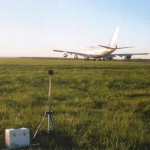 Research conducted by the Applied Acoustics Branch can be grouped into three broad areas:
Research conducted by the Applied Acoustics Branch can be grouped into three broad areas:
— Understanding, predicting, and controlling the excitation and response of aerospace structures to fluctuating pressures
— Performing subjective acoustics research to establish verified, quantifiable noise criteria for the impact of aviation noise on communities and passengers
— Developing noise control concepts and technologies for engine nacelles and airframes
A major objective of the first area is to develop validated analytical and numerical models of sound transmission in and through aerospace structures such as fuselage sidewalls. These models are used to design quieter sidewalls that meet structural requirements, or to develop and optimize noise control treatments. This area of research includes the development of novel structures to reduce sound generated by aerodynamic sources such as the flow around high-lift surfaces on an aircraft.
The subjective acoustics research area includes the study of human response to novel aviation noise sources including low-boom supersonic aircraft and vehicles for the Urban Air Mobility (UAM) mission. This includes atmospheric propagation of sonic booms, survey methods to assess community response to sonic thumps, and methods to combine measurements and predictions to determine the sound levels experienced by community members. The subjective acoustics area also includes auralization of aircraft sounds, whereby recorded segments or predictions from source noise models are used to create realistic pseudo-recordings that can be played to listeners in the lab for human response studies.
In the area of noise control technologies and concepts, branch researchers rely on experiments and analyses to understand, predict, and develop specialized acoustical absorbing materials for jet engine inlets, aft bypass ducts, and areas of the airframe near or close to airframe noise generation sources. Areas of the airframe that could benefit from acoustical liners include the fuselage surface, flap side edges and landing gear doors.
The research in all of these areas utilizes unique facilities housed within the Applied Acoustics Branch for simulating the noise and vibration environments experienced by flight structures, passengers and crew, and communities exposed to aircraft noise.